Root rot – leaf rot is a common phenomenon that it seems that anyone who grows snake plants has experienced it. Disease progression in soil is very slow and difficult to detect. However, once the disease has appeared on the leaves, the plant will “sleep” very quickly because the disease has caused waterlogging of the entire roots. In this article, we will go through the causes of root rot on snake plants , the symptoms and most importantly, how to cure them if unfortunately your plants also encounter this condition.
We all know that plant roots absorb water, nutrients and especially oxygen from the soil. That’s right, under tree roots, respiratory activity also occurs like us. But when it is wet for a long time, oxygen cannot circulate in the soil. Therefore, the roots gradually suffocate. Pathogens also benefit from the anaerobic environment and grow faster, attacking the already weakened root system. As a result, the roots “rot” into slimy, brown or black fibers, and sometimes even smell rotten.
Waterlogged roots mean “dead” roots, they cannot absorb nutrients from the soil. This affects the growth of the entire plant. And if not treated promptly, the “waterlogging” will gradually spread to all the roots, spread up the tree trunk and cause the tree to “sleep”.
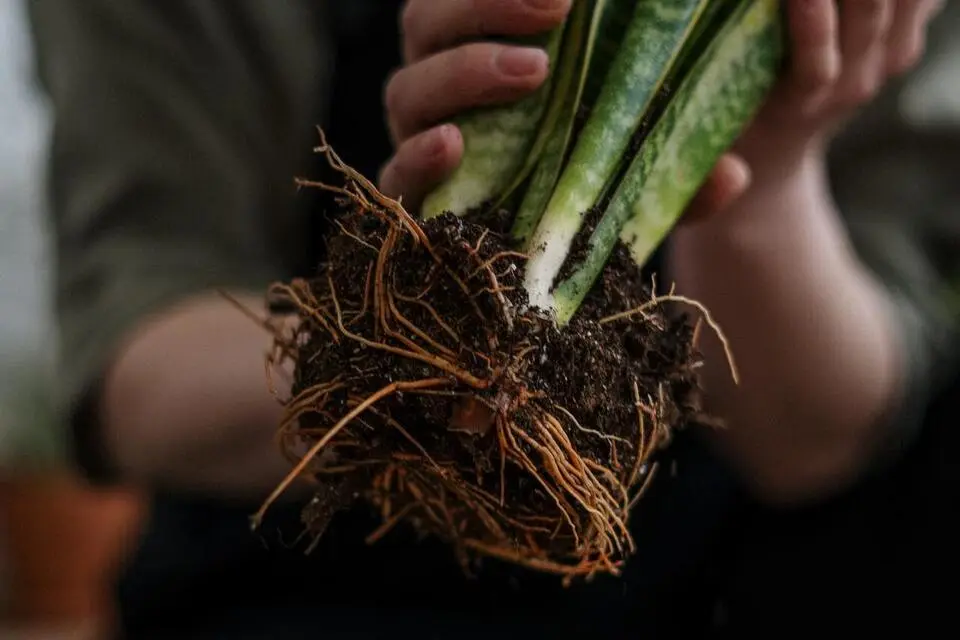
Contents
What causes the Tiger Tongue tree’s roots to rot?
Root rot can occur from two main causes – one is due to the soil being wet and soggy for too long and the other is due to the presence of fungus. Below are the factors that cause these two problems:
Watering too often
Many people who are new to growing snake plants often make the same mistake – watering them too often. Most snake plants grown indoors have low water needs, and they prefer dry environments to constant humidity.
For snake plants , keep in mind the following watering rules:
- Only water when the planting medium has dried 2-3cm on the surface. The time between waterings may vary depending on the actual weather. Normally, watering once a week is enough. However, if it’s the cold season, you may only need to water once every 2 weeks.
- With each watering, water slowly and thoroughly so that the substrate is fully hydrated.
Drainage problem
As discussed, long-term stagnation of water in the soil is a common cause of waterlogging and root rot. If the environment cannot drain well, no matter how thoroughly watered it, the snake plant will always be under the “scythe of death”. There are two factors to consider when it comes to drainage – the growing medium – and the pot.
Planting pots and drainage system
The pot for planting the snake plant must have drainage holes to allow excess water to flow out. If placing the pot on a saucer, make sure to discard any water that flows out after a period of watering (I usually leave it for 30 minutes). If water is allowed to stagnate in the dish, the roots will be in a state of always “sitting in water”.
Tip: Use the pot lifting technique so you don’t have to pour out excess water after each watering. Use large pebbles or terracotta stones (lightweight pebbles) to form a layer on the base, then place the pot on it. This liner will form an automatic self-watering system that prevents the roots from touching excess water, when water is needed. Besides, when roots are thirsty, they can also absorb excess water for use. You can also place this liner inside the pot. However, terracotta pellets or pumice stones would be better in this case.
In addition, an oversized pot can also make the snake plant more susceptible to root rot. The reason is that large pots often contain a lot of soil, which causes them to retain more moisture and become harmful to the plant.
Tip: Choose a pot large enough to accommodate the plant’s roots. And only increase the pot diameter by 1-1.5 inches each time you repot (usually every 1-2 years).
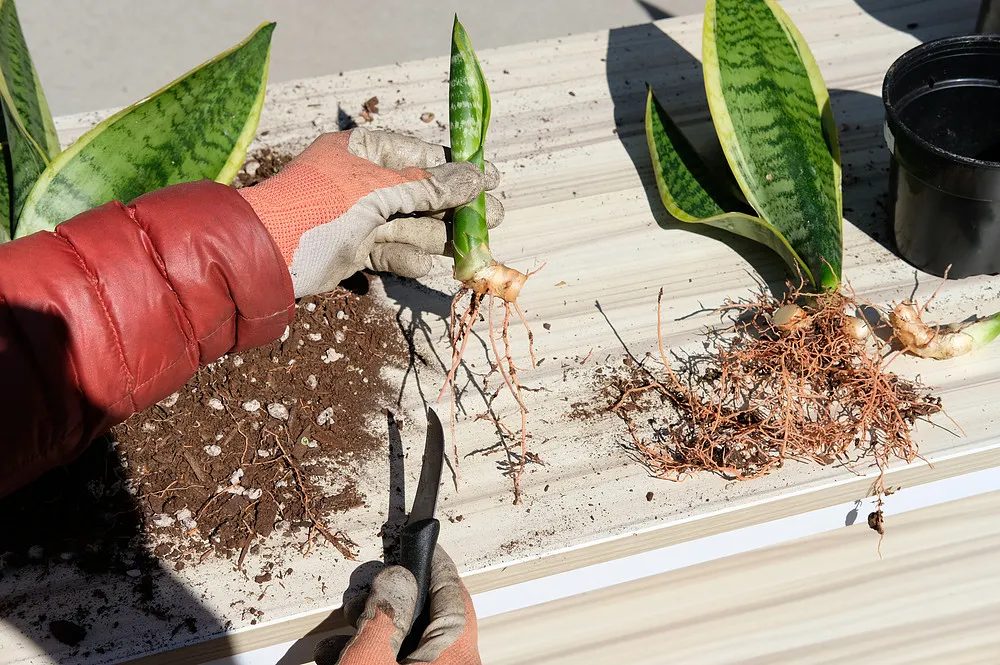
Heavy – old substrate with poor drainage
The substrate for planting snake plants must have very high ventilation. We do not use regular soil or garden soil to grow snake plants indoors. The soil is too heavy and easily compacted after a period of planting, making it impossible for water to drain away quickly. This factor will stimulate pathogens to grow rapidly and cause root rot.
On the other hand, even though a substrate has good drainage initially, over time it will gradually “age”. This is because the components in the medium begin to decompose into humus, causing them to become denser and less draining. Therefore, pay attention to changing the substrate every 12-18 months or maybe sooner, if you see that the condition of the substrate has deteriorated.
Another factor that gets little attention is salt accumulation. When you water your plants with hard water (water from the shower) or when you fertilize, the soil will gradually accumulate those dissolved minerals. Soil salinity will affect the permeability of the soil and roots, causing more stress on the roots.
Infection from pruning tools
Whenever pruning, propagating or repotting, it is important to use sterilized tools. The parts that have just been cut are sensitive points like an “open wound”. They are vulnerable to potential pathogens and bacteria.
Tip: disinfect tools with 70 degree Isopropyl alcohol. Use a cotton ball soaked in the solution to wipe the tool, and wipe again after each cut.

Signs of waterlogged snake plant – root rot
Early detection of root rot is very important to take early treatment measures. But unfortunately, the first symptoms of this disease occur below the soil surface. But we cannot notice the problem until the disease becomes more serious and spreads to other parts. Therefore, pay attention to snake plants if they have the following signs:
Yellow leaves
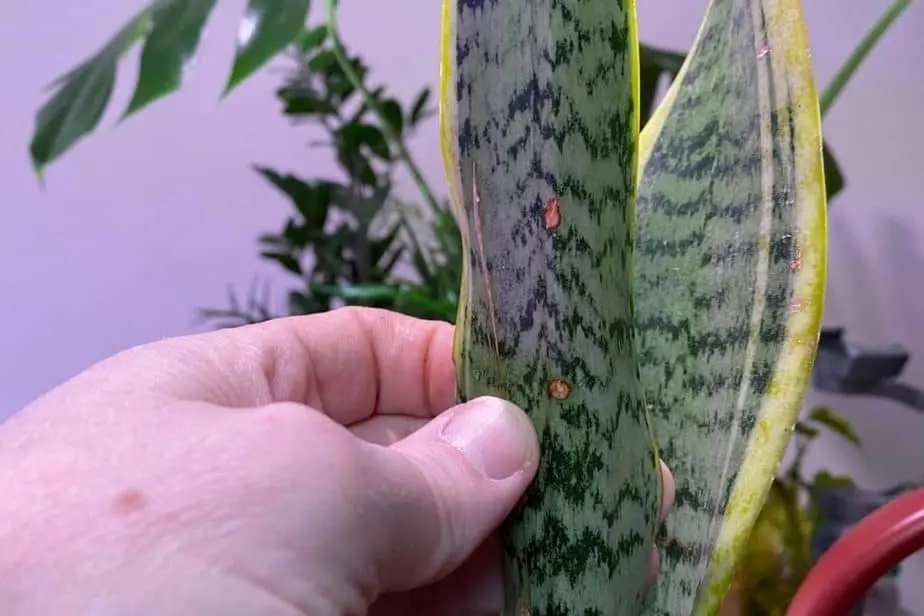
Slow growth and yellowing leaves are some early warning signs that the roots may be in trouble. Sansevieria is a relatively slow growing plant, so we often do not notice this factor. However, yellow leaves are a prominent sign that the snake plant is suffering from root rot. However, the fortunate thing is that at this time the snake plant’s roots have not been completely affected.
When the roots are damaged, the leaves begin to wilt, become soft and limp, turn yellow and droop. Usually the outer leaves are affected first, followed by the remaining inner leaves.
Leaves appear reddish brown or black spots
These two symptoms are not necessarily signs of root rot, they are actually caused by fungi. However, the progression of the disease is a sign that the growing medium has been wet for a long time. This gives pathogens the opportunity to attack the already weak root system due to being suffocated by water. Over time, these factors cause tree roots to gradually die.
Stinking smell from the soil
The characteristic feature of root rot on snake plants is the stench. Healthy roots will have an earthy scent or no scent at all. If you pay attention, you will also see that insects such as flies and houseflies are also attracted by this smell and often fly around the pot.
The soft roots are dark brown in color
When you detect the above signs, it is better to immediately take the plant out to check the roots. Snake plant roots will usually be white or dark yellow. However, as the root rot progresses, the roots decompose into slimy, dark brown, and foul-smelling fibers that, when gently pulled, fall off the tree.
How to save your snake plant from root rot?
In my experience, a snake plant whose roots have been damaged is very difficult to save. However, the survival rate of the tree is still quite high if treated in the early stages of the disease. Check the roots carefully. If all the roots are mushy, the only option is to cut off the plant. Carefully remove the damaged stump and do not let it come into contact with other healthy roots in the pot. Make sure you sterilize your tools before cutting, and replace the potting medium with new ones for healthy plants.
However, if there are still living roots, you can try to get the plant back to health. Even though most of the foliage is dead, as long as some healthy roots remain, the sansevieria can certainly regrow new young. The first and most important thing is to act quickly. Start treatment as soon as possible to give your tree the best chance of survival.
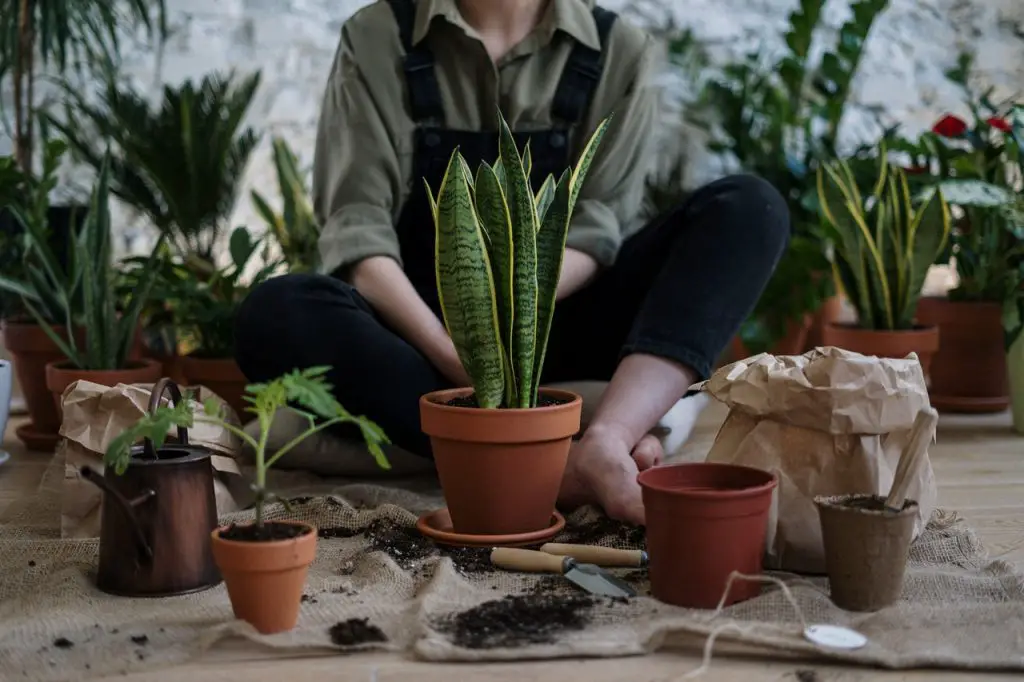
Treating snake plants with root rot
- Once you have removed the plant from the pot and identified the disease, try to remove the old soil clinging to the roots. Then, continue rinsing the roots under running water to remove as much soil as possible.
- Use sharp scissors or sterilized pruning shears to cut off all damaged parts. Including blackened roots and yellow and withered leaves. This step requires you to remove a significant amount of plant parts. However, it is better to cut cleanly than to leave diseased parts behind, causing them to continue to spread.
- This step is optional, but recommended. Dip healthy roots in fungicide or add it to the soil to kill any fungi that can cause root rot. In the next section, there is a list of fungicides. You can use any one of them.
- The final step is to replant the tree in a new substrate and new pot. If using an old pot, clean and disinfect the pot.
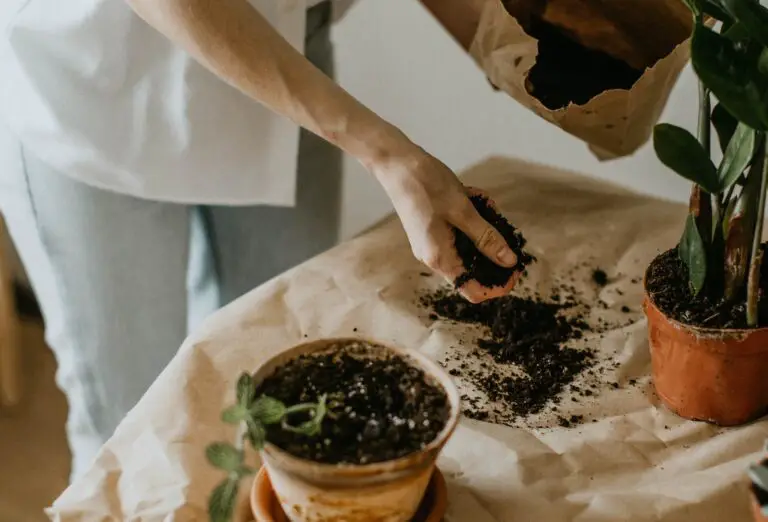
Enhanced fungal treatment – limit the spread of disease to snake plants with waterlogged roots
To ensure that pathogens are completely eliminated and do not easily attack future plants, treat your plants with some type of fungicide. Below are some commonly used types.
Cinnamon
Few people think that a common kitchen spice like cinnamon can fight fungus. Cinnamon contains cinnamaldehyde, which research shows is effective against fungal infections in more than 40 different crops. Cinnamon is often used to eliminate pests in the soil, protect seedlings and prevent root rot.
To treat your troubled snake plant, dust the roots with a little cinnamon and apply to the newly pruned sections. Don’t forget to mix some into the soil, too. You can also use cinnamon essential oil, but dilute it with some carrier oil.
Neem Oil
Another organic multipurpose product you can use is neem oil. This oil is extracted from the kernel of the neem fruit. It can eliminate fungus, mold, downy mildew etc. This natural pesticide will also repel insects, nematodes and bacteria.
It is usually used in spray form. Add 1 teaspoon (5 ml) of neem oil in 1 quart (1 quart) of warm water with half a teaspoon of mild liquid soap. Shake well and spray on affected parts of the plant.
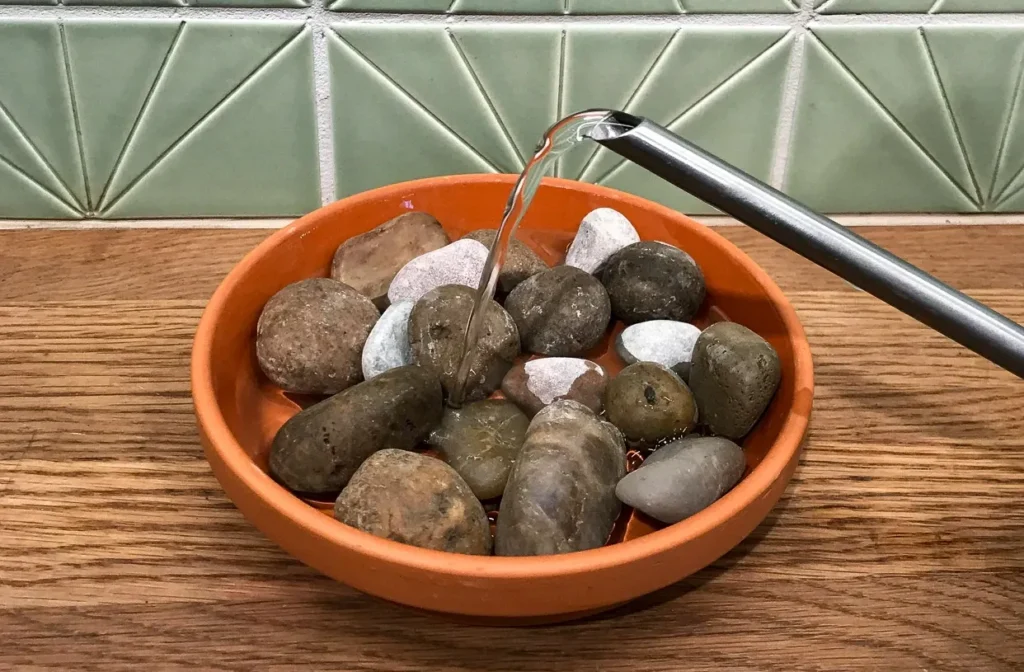
Hydrogen Peroxide (H2O2)
Another easily available potential root rot treatment is Hydrogen Peroxide solution (common name is Hydrogen Peroxide). When a small amount of peroxide is added to water, it breaks down into water and oxygen molecules. This helps control fungal gnawing by providing oxygen to plant roots.
Dilute about 1 teaspoon of 3% H2O2 solution in a cup of water. Then dip the roots and other affected parts in the diluted solution before repotting. It can also be mixed into soil or added to a watering can. When you water your snake plant , add about 1 tablespoon of hydrogen peroxide to 1 quart of water. Use it for root dipping, mixing in soil or while watering. Don’t try all three as it may be too much.
Specialized fungicide
Commercial fungicides can be inexpensive and quickly effective in eliminating fungi. But they can damage beneficial microorganisms in the soil. This can make the tree weaker and more susceptible to rot. So if possible, save it as a last resort.
Caring for a snake plant with waterlogged roots after “treatment”
- After repotting, leave the plant alone for a few days without watering
- Then carefully reset the watering schedule. Water sparingly at first until the roots recover and begin to produce new leaves. When plants are cut back, they need less water.
- Keep the snake plant in a moderately bright place, away from harsh sunlight.
- Avoid fertilizing until the plant is healthy again. Damaged roots will not be able to absorb nutrients and may burn. Fertilizer is not a medicine and should not be used on diseased plants.
This is quite a long article, but I’m glad if you took the time and read this far. Hopefully these small sharings from the Tree Family will help detect root rot disease on snake plants in time and save the tree.

